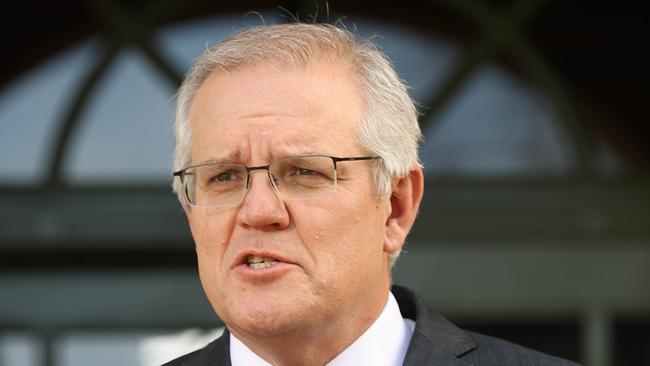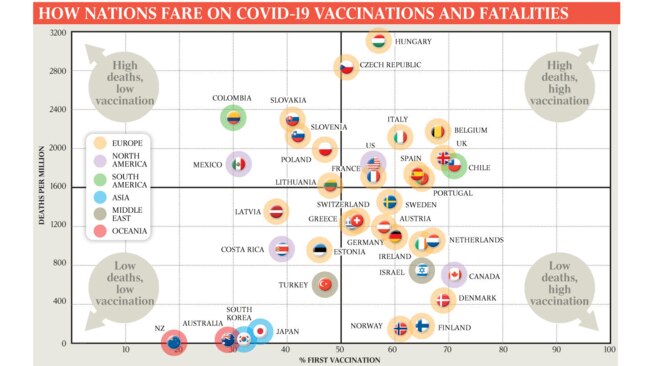
But the Prime Minister has long sought to remind Australians of the successes we’ve had managing the pandemic itself. This essentially pits the vaccine rollout against deaths from Covid-19, which can be neatly examined country by country on a simple x and y axis graph, as we’ve done here with OECD nations.
Plotting nations along the horizontal and vertical axis according to deaths per million (the vertical axis) and percentage of first doses of the vaccine administered (the horizontal axis) gives us a visual picture of overall performance managing the twin most important facets of the pandemic.
I’ve picked first doses rather than second doses because the latter distorts the data according to the type of vaccine used and the time frame between the two. Equally, I have used vaccinations as a percentage of the total population rather than the eligible population because eligibility is distorted by national decision-making criteria and approvals.
You can see that for the most part nations like Australia, which have kept deaths per million low, have struggled to replicate the speed of the vaccine rollout in countries where the death rate was higher. New Zealand and Australia are the two countries that have most successfully limited the number of deaths but are also the two countries with the lowest percentage of the population to have received their first vaccine dose. South Korea comes in third for keeping deaths under control and, lo and behold, it’s also one of the worst performers at rolling out vaccines.
It’s no coincidence that Middle Eastern and Asian countries sit within the top 10 for avoiding deaths and by and large their rollouts have been slow.
Equally, most European countries and the US have poor datasets for deaths, but their vaccine rollouts have been among the best. This isn’t surprising, either, because pharmaceutical operations are centred on Europe and the US, so they have benefited from that geographic advantage hand in glove with the geographical disadvantage they faced during the contagion.
The Scandinavian countries of Denmark, Finland and Norway are the only exceptional European nations within the data set that have done well on both deaths and the rollout.
Sweden did not enjoy similar success on deaths, and in fact its vaccine rollout has also been slightly slower than in the other Scandinavian nations.

Nations in Europe and the Americas that managed deaths poorly and have also been slow rolling out the vaccine are generally less developed than those positioned around them.
So what does the data tell us? While the correlations aren’t entirely precise, there is a bias in the data towards good management of Covid, resulting in a slower vaccine rollout.
Distortions abound of course – for example geographically and in terms of relative prosperity – but for the most part countries that did well keeping a lid on deaths have struggled to do as well rolling out vaccinations.
This rollout failure in some countries is likely a consequence of increased vaccine hesitancy because of a lack of perceived urgency, vaccines supplies targeting (wealthy) nations with greater need, as well as slower official or emergency approvals because of fewer outbreaks and less stress on the health systems.
Peter van Onselen is a professor of politics and public policy at the University of Western Australia and Griffith University.




Scott Morrison has finally apologised for the slow vaccination rollout, doing so this week.